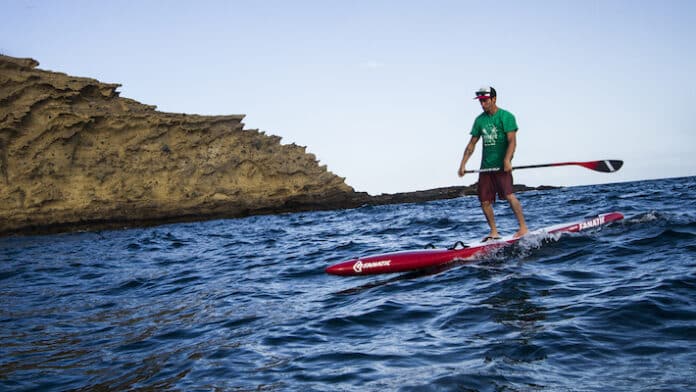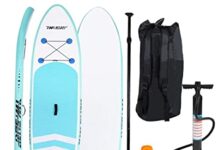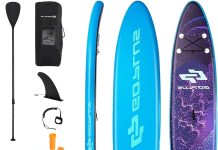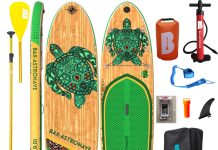Windy days on the water can be thrilling and challenging for both the experienced SUPer and the beginner.
The idea is not to be afraid of the wind. But to understand the situation and make it as safe as possible.
Review contents
Windy SUP Excursions
Moreover, a few tweaks can make your paddleboarding experience more enjoyable.
So, here are seven tips to help make your SUP trip more enjoyable and safer,
- Choose The Right Board
- Bring Safety Gear & Supplies
- Practice The Basics
- Plan Your Route
- Get Past The Whitecaps
- Efficient Paddling
- Rest & Recover In-Between Paddling
Choose The Right Board
SUPing on a windy day means you must paddle against the wind and waves to make the experience enjoyable. So, you must choose a board to help you do this.
Luckily for us, there are boards designed specifically for these types of conditions!
This section will discuss how boards differ depending on the conditions and what might work best for your needs.
If you find yourself wanting to SUP on one of these windy days, here’s what you need to know about choosing the right board,
- The wider your board is, the more stable it will be
- A longer board with a pointy nose will be less versatile but will catch less wind and cut waves more efficiently
- A rounded nose all-around board will be universal, but it will also see more wind
- In case the board has a cutaway tail, it will offer better stability in the rough waters
- The hybrid durable surf SUP board will have an easier time combating the wind and the waves
- Going with a smaller SUP may seem attractive, but it will be dangerous to SUP with it on a windy day
VERDICT
A stable and durable board with a pointy or hybrid nose is ideal.
Bring Safety Gear & Supplies
With the wind in your hair and the waves lapping against your board, SUPing can be a thrilling experience. But when you’re out on the water, it’s essential to have supplies and safety gear to keep you safe and sound!
To make your paddleboarding experience as enjoyable and as safe as possible here’s what you need to bring,
- A Coast Guard Approved PFD. Not only will it save your life in an emergency, but you also need it to be legal in the water.
- Strong SUP leash with padded ankle cuff. With it, you won’t have to swim after a board that is floating away or deals with a chafed knee.
- Plenty of drinking water and some food. You will need the water to stay hydrated and the food for extra calories. Paddling in the wind is harsh.
- An emergency whistle. This item may seem insignificant, but you will be surprised by its effectiveness in certain conditions.
Read Next – Best Life Belts Buying Guide
VERDICT
Don’t be the person who forgets to wear a PFD and a safety leash. Also, bring drinking water, food, and an emergency whistle with you.
Read Next – MaxKare Inflatable Paddle Board SUP
Practice The Basics
A few simple practice sessions of basic techniques will make windy SUP excursions enjoyable and safer.
When preparing to SUP in windy weather, you need to,
- Understand the wind and the waves. Learn to read wind directions and the flow of currents before you head out
- Practice the basic paddle strokes in calm, low-risk areas. This way, you will have better control over your SUP
- Learn to balance appropriately on top of your board. After all, it’s going to be challenging to balance in rough weather
- Practice the efficient paddle grip and stance. You will need to conserve as much stamina as you can for emergencies
- Brush up on your swimming skills. There’s a pretty high chance of hitting the water, and it’s better to be safe than sorry
Read Next – Best Inflatable Paddle Board For Beginners
VERDICT
Learn about the weather and practice paddle strokes, balancing, grip, stance, and swimming before SUPing.
Read Next – Aqua Plus Inflatable SUP for All Skill Levels Boat Review
Plan Your Route
It’s essential to plan your route before going paddleboarding in windy conditions. This method will enable you to have a smooth and safe experience.
Here’s how you can plan your SUPing route,
- Pay attention to the weather forecast and choose a relatively calmer moment to start your excursion.
- Try to locate a local paddleboarder or an experienced guide to help you understand the area.
- Find an appropriate entry point. Look for a safe location to enter the water where there are no swimmers, vessels, or a few.
- If you are going for a long excursion, then bring a waterproof map
- Mark the hazardous areas and rocks on your map beforehand
VERDICT
Listen to the weather forecast, learn from the locals, enter a less crowded area, and remember to bring a marked map for extended outings.
Get Past The Whitecaps
If you’re an avid SUP enthusiast who lives in a windy area, you probably know that the whitecaps can make paddleboarding more complex and dangerous. A lot of injuries that paddleboarders suffer are from these breaks.
Therefore, It’s crucial to find out how to get past the whitecaps so your next excursion will be enjoyable and safe.
Let’s take a look at how you can get past those pesky whitecaps,
- Don’t wade too far into the water before placing your board. The wave may pull it away from you!
- Aim the nose of your board straight against the waves. This method will help you cut locks better.
- Try to find the delay between waves. This delay is the perfect time to get past the initial break.
- If you lose balance quickly, you can also try to get past the whitecaps paddling like a surfer.
VERDICT
Only go into the water as needed to place your board, aim the board nose straight, paddle when there is a delay between waves, and lay down on your board to surf and paddle if you find it difficult.
Efficient Paddling
The wind can make SUPing difficult and inefficient. However, there are ways to make your paddling more efficient to enjoy the watersport despite the weather.
For instance, you can,
- Kneel while paddling. Your body works as a sail for the board, so you will catch less wind while kneeling.
- Try not to let the waves hit the sides of your board when you paddle. These waves add side momentum and may even make you fall off your paddleboard.
- Engage your core while you paddle. Only paddling with arm muscles is inefficient and will quickly tire you out.
- Try to reach as far forward as you comfortably can while paddling. As per Newton’s third law, the more water you catch and the longer your stroke, the more power you will get from the paddling.
- Develop a rhythm for your paddle strokes. You can utter a small mantra-like “Breath” between each paddle stroke.
VERDICT
Paddle while kneeling, cut through the waves, engage your core muscles to reach far with the paddle, and try to paddle in rhythm for better paddling efficiency.
Rest & Recover In-Between Paddling
Exhaustion can creep in silently when you are battling the winds. So, taking rests and recovering in between intense paddling sessions is essential.
However, finding shelter can be pretty hard when you are out in the water. So, here is how you can rest and recover in between paddling,
- Thoroughly stretch out your muscles after five to ten minutes of paddling. This stretching will help you avoid accidental injuries and increase your focus.
- Take in deep breaths when the paddle blade is out of the water. You need to get your body oxygenated as best as possible in this short window.
- Remember to alternate sides while paddling. This way, you can rest some muscles while others provide power.
- Kneel or lay down on the board if you are running on fumes. You mustn’t overexert your muscles in the water.
- In an emergency, you can lower your SUP anchor and rest quickly.
Check out the Best Paddle Board Anchor for more details on SUP anchors.
VERDICT
Periodically stretch your muscles, take deep breaths, paddle on both sides, kneel or lay down to rest, and use a SUP anchor if necessary to recover your stamina.
Read Next – Aqua Plus Inflatable SUP for All Skill Levels Boat Review
Summing Up
As long as you follow these seven tips, you should be able to SUP efficiently, even in windy weather and rough water.
Moreover, these tips are not limited to windy day SUP excursions only. You will find that most of them are helpful in your everyday recreational SUPing.
Keep in mind that the water is unpredictable. So, be prepared to deal with surprises when you are out in the water.
We hope you’ve found a few ways to make your next SUP excursion more enjoyable and safer.
But don’t just take our word for it. Try out these windy days’ paddling tips today!
Read Next – Goosehill Inflatable Stand-Up Paddle Board
Tips For Paddle Boarding On A Windy Day
Read Next – Best Solid Paddle Boards in 2022

































